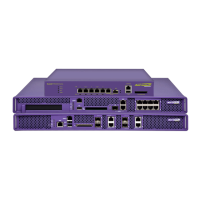Summit WM3000 Series Controller System Reference Guide 91
The following details display in the table:
4 Select an entry and click the Delete button to remove the selected entry from the IP forwarding table.
5 Click the Add button to create a new static route. For more information, see “Adding a New Static
Route” on page 91.
6 Click Enable (to allow) or Disable (to deny) routing between VLANs.
Adding a New Static Route
Use the Add screen to add a new destination subnet, subnet mask and gateway for routing packets to a
defined destination. Use the screen when an existing destination subnet does not meet the needs of the
network.
To add a new static route:
1 Click the Add button.
A new Configuration screen displays enabling you to add a new destination subnet, subnet mask and
gateway for routing packets to a defined destination.
Destination Subnet
Displays the mask used for destination subnet entries. The Subnet Mask
is the IP mask used to divide internet addresses into blocks (known as
subnets).
Subnet Mask
Displays the mask used for destination subnet entries. The Subnet Mask
is the IP mask used to divide internet addresses into blocks (known as
subnets). A value of 255.255.255.0 will support 256 IP addresses.
Gateway Address
Displays the IP address of the Gateway used to route the packets to the
specified destination subnet. Do not set the gateway address to any VLAN
interface used by the controller.
Interface
Displays the interface name with which the destination subnet entries are
attached.
Protocol
Displays the name of the routing protocol with which this route was
obtained. Possible values are:
Static
— Routes are statically added by the operator.
DHCP
— Routes obtained from the DHCP server.
Connected
— Routes automatically installed by the controller for directly
connected networks based on interface IP addresses.
Kernel/ ICMP
— Routes added as a result of receiving an ICMP redirect
from an intermediate router.
Active
When IP Forwarding is enabled for the selected subnet, a green check
displays in the Active column. A red X defines the subnet as disabled.

